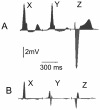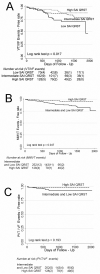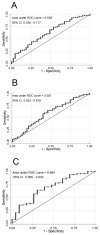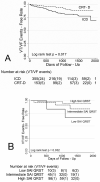A new electrocardiogram marker to identify patients at low risk for ventricular tachyarrhythmias: sum magnitude of the absolute QRST integral
- PMID: 21093871
- PMCID: PMC3058724
- DOI: 10.1016/j.jelectrocard.2010.08.012
A new electrocardiogram marker to identify patients at low risk for ventricular tachyarrhythmias: sum magnitude of the absolute QRST integral
Abstract
Objective: We proposed and tested a novel electrocardiogram marker of risk of ventricular arrhythmias (VAs).
Methods: Digital orthogonal electrocardiograms were recorded at rest before implantable cardioverter-defibrillator (ICD) implantation in 508 participants of a primary prevention ICDs prospective cohort study (mean ± SD age, 60 ± 12 years; 377 male [74%]). The sum magnitude of the absolute QRST integral in 3 orthogonal leads (SAI QRST) was calculated. A derivation cohort of 128 patients was used to define a cutoff; a validation cohort (n = 380) was used to test a predictive value.
Results: During a mean follow-up of 18 months, 58 patients received appropriate ICD therapies. The SAI QRST was lower in patients with VA (105.2 ± 60.1 vs 138.4 ± 85.7 mV ms, P = .002). In the Cox proportional hazards analysis, patients with SAI QRST not exceeding 145 mV ms had about 4-fold higher risk of VA (hazard ratio, 3.6; 95% confidence interval, 1.96-6.71; P < .0001) and a 6-fold higher risk of monomorphic ventricular tachycardia (hazard ratio, 6.58; 95% confidence interval, 1.46-29.69; P = .014), whereas prediction of polymorphic ventricular tachycardia or ventricular fibrillation did not reach statistical significance.
Conclusion: High SAI QRST is associated with low risk of sustained VA in patients with structural heart disease.
Trial registration: ClinicalTrials.gov NCT00733590.
Copyright © 2011 Elsevier Inc. All rights reserved.
Figures







Similar articles
-
Ventricular arrhythmia is predicted by sum absolute QRST integralbut not by QRS width.J Electrocardiol. 2010 Nov-Dec;43(6):548-52. doi: 10.1016/j.jelectrocard.2010.07.013. Epub 2010 Sep 15. J Electrocardiol. 2010. PMID: 20832820 Free PMC article.
-
Dynamic Changes in High-Sensitivity Cardiac Troponin I Are Associated with Dynamic Changes in Sum Absolute QRST Integral on Surface Electrocardiogram in Acute Decompensated Heart Failure.Ann Noninvasive Electrocardiol. 2017 Jan;22(1):e12379. doi: 10.1111/anec.12379. Epub 2016 Jun 6. Ann Noninvasive Electrocardiol. 2017. PMID: 27265641 Free PMC article.
-
ECG marker of adverse electrical remodeling post-myocardial infarction predicts outcomes in MADIT II study.PLoS One. 2012;7(12):e51812. doi: 10.1371/journal.pone.0051812. Epub 2012 Dec 14. PLoS One. 2012. PMID: 23251630 Free PMC article.
-
[Tachycardia detection in implantable cardioverter-defibrillators by Sorin/LivaNova : Algorithms, pearls and pitfalls].Herzschrittmacherther Elektrophysiol. 2016 Sep;27(3):213-25. doi: 10.1007/s00399-016-0458-y. Epub 2016 Sep 7. Herzschrittmacherther Elektrophysiol. 2016. PMID: 27605232 Review. German.
-
Systematic Review for the 2017 AHA/ACC/HRS Guideline for Management of Patients With Ventricular Arrhythmias and the Prevention of Sudden Cardiac Death: A Report of the American College of Cardiology/American Heart Association Task Force on Clinical Practice Guidelines and the Heart Rhythm Society.Circulation. 2018 Sep 25;138(13):e392-e414. doi: 10.1161/CIR.0000000000000550. Circulation. 2018. PMID: 29084732
Cited by
-
Electrocardiogram machine learning for detection of cardiovascular disease in African Americans: the Jackson Heart Study.Eur Heart J Digit Health. 2021 Jan 20;2(1):137-151. doi: 10.1093/ehjdh/ztab003. eCollection 2021 Mar. Eur Heart J Digit Health. 2021. PMID: 34048510 Free PMC article.
-
Dynamic predictive accuracy of electrocardiographic biomarkers of sudden cardiac death within a survival framework: the Atherosclerosis Risk in Communities (ARIC) study.BMC Cardiovasc Disord. 2019 Nov 14;19(1):255. doi: 10.1186/s12872-019-1234-9. BMC Cardiovasc Disord. 2019. PMID: 31726979 Free PMC article.
-
Vectorcardiogram in athletes: The Sun Valley Ski Study.Ann Noninvasive Electrocardiol. 2019 May;24(3):e12614. doi: 10.1111/anec.12614. Epub 2018 Nov 7. Ann Noninvasive Electrocardiol. 2019. PMID: 30403442 Free PMC article.
-
Optimal configuration of adhesive ECG patches suitable for long-term monitoring of a vectorcardiogram.J Electrocardiol. 2017 May-Jun;50(3):342-348. doi: 10.1016/j.jelectrocard.2016.12.005. Epub 2016 Dec 29. J Electrocardiol. 2017. PMID: 28069275 Free PMC article.
-
Novel measure of electrical dyssynchrony predicts response in cardiac resynchronization therapy: Results from the SMART-AV Trial.Heart Rhythm. 2015 Dec;12(12):2402-10. doi: 10.1016/j.hrthm.2015.08.009. Epub 2015 Aug 10. Heart Rhythm. 2015. PMID: 26272523 Free PMC article. Clinical Trial.
References
-
- Lloyd-Jones D, Adams R, Carnethon M, De SG, Ferguson TB, Flegal K, Ford E, Furie K, Go A, Greenlund K, Haase N, Hailpern S, Ho M, Howard V, Kissela B, Kittner S, Lackland D, Lisabeth L, Marelli A, McDermott M, Meigs J, Mozaffarian D, Nichol G, O'Donnell C, Roger V, Rosamond W, Sacco R, Sorlie P, Stafford R, Steinberger J, Thom T, Wasserthiel-Smoller S, Wong N, Wylie-Rosett J, Hong Y. Heart disease and stroke statistics--2009 update: a report from the American Heart Association Statistics Committee and Stroke Statistics Subcommittee. Circulation. 2009;119:480–6. - PubMed
-
- A comparison of antiarrhythmic-drug therapy with implantable defibrillators in patients resuscitated from near-fatal ventricular arrhythmias. The Antiarrhythmics versus Implantable Defibrillators (AVID) Investigators. N Engl J Med. 1997;337:1576–83. - PubMed
-
- Moss AJ, Zareba W, Hall WJ, Klein H, Wilber DJ, Cannom DS, Daubert JP, Higgins SL, Brown MW, Andrews ML. Prophylactic implantation of a defibrillator in patients with myocardial infarction and reduced ejection fraction. N Engl J Med. 2002;346:877–83. - PubMed
-
- Bardy GH, Lee KL, Mark DB, Poole JE, Packer DL, Boineau R, Domanski M, Troutman C, Anderson J, Johnson G, McNulty SE, Clapp-Channing N, Davidson-Ray LD, Fraulo ES, Fishbein DP, Luceri RM, Ip JH. Amiodarone or an implantable cardioverter-defibrillator for congestive heart failure. N Engl J Med. 2005;352:225–37. - PubMed
-
- Goldenberg I, Vyas AK, Hall WJ, Moss AJ, Wang H, He H, Zareba W, McNitt S, Andrews ML. Risk stratification for primary implantation of a cardioverter-defibrillator in patients with ischemic left ventricular dysfunction. J Am Coll Cardiol. 2008;51:288–96. - PubMed
Publication types
MeSH terms
Associated data
Grants and funding
LinkOut - more resources
Full Text Sources
Medical

